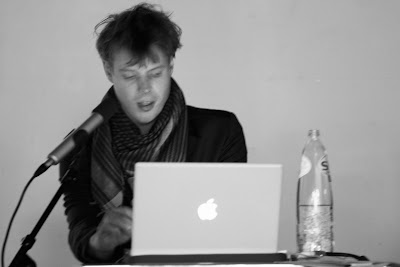
Daijiro Mizuno and Bas Rajmakkers
Photograph by Susana Camara
Article by Carolina dos Santos Reis
Young PhD Daijiro Mizuno took us on a journey through his work and views on design during his presentation last Friday, 27 March in the Design Academy auditorium. Unlike most of our lecturers that are active designers designing commercial products, he distinguishes himself by focusing his investigation on the act of designing itself. He surprised us with new and different perspectives showing us how all components of the creative process overlap.
If I were to describe Mizuno in three words, they would be passionate, curious and playful – all qualities a designer needs to pursue studies at the higher level and dedicate his career to research. Although Mizuno feels there is no difference between Japanese and Western design anymore, he is influenced by his environment. Since he is now spending most of his time in Japan, his Paperbag Girls project was an installation showcasing the phenomenon of Japanese women who collect branded paper bags, carrying them as a secondary bag carefully matched to their outfit. Even if this is very particular of the nippon society where fascination and addiction to brands is at it’s strongest expression, it happens also in other countries. Mizuno’s interest goes beyond the local cultural definitions. He would rather elaborate on why and how this represents new Zeitgeist as a contemporary form of consumption. This project was inspired on the theories of Bourdieu and Foucault, on accumulated photographic data and influenced his students to create new paperbags. What emerges from this study is how ideas are interwoven between theory, research and practice.
In his professional discourse, Mizuno cites issues like identity, ethics, sociology, history, economics, and psychology, among others, to understand fashion. But his main interest is the irrational dimension present in fashion. For instance, when he studied Universal Fashion Design, that is, garments specially designed for physically impaired persons, he questioned why they were so dull and unattractive, and why it is so important for fashion to offer irrational matters as a social object related to identity. This led him to develop a collection of clothing based on analyzing the physical limitations of the disabled and the kinetics of the body. While the resulting pieces looked like ordinary garments, they had hidden details that facilitated mobility.
Mizuno’s fascination about how designers make sense of themselves led him to focus on the mechanisms of the design process and its inspirational sources for his PhD thesis. When he worked as a part time assistant for Shelley Fox, he became very intrigued with the creative process and how the formal outcome emerges. This motivated him to study the mechanisms of the process more deeply, by both examining other designers and his own method. He stresses intuitive properties in the development of design and the importance of synaesthetics in the outcome of creations. His investigation was based on the concept of orality by Walter J. Ong, to find the traces of tangible shapes hidden in the language and expression of fashion. To cite Mizuno’words, he “applied "Orality" as a means to analyse the psychodynamics of designers represented as clothing design. It can mean shapes of collars etc..., although it can be problematic to analyse clothing in linguistic manner”. Moreover, he used the theories of Seigo Matsuoka, an editorial engineer, to critically reflect on how ideas arise. According to Matsuoka, the world is composed of a sum of information and the idea is the synthesis of this; this is where intuitive enlightenment begins. To better explain his investigation, Mizuno assembled diagrams to help us visualise the links between all parts, and to identify clusters and reoccurring patterns.
Another project he is working on is Belonging and Belongings with STBY, a social research service for design innovation. It examines identity through different means and how style is associated to location; in other words, how a context can alter what is communicated by a subject, and conversely, how a subject can influence the perception of a place.
What arose is that the most common objects of daily use, like clothing, often encompass the most complex considerations, including social matters like identity, communication and moral values. Maybe it was the richness of this content, touching on such intricate, abstract and diverse subjects, that made us seem somewhat perplexed at the end of the presentation. Maybe it was the hidden theme of his lecture, as he later explained to me, that challenged our own preconceived notions - to demonstrate how theory, research and practice can be incorporated without conflicts.
The lecture would not have been complete without the workshop introduced by Bas Rajmakkers that followed. The students of the Man & Humanity Master programme were able to reflect on and discuss their own creative and research processes using a diagram based on Mastuoka’s concepts. In this way, Mizuno shared a part of his work in a more practical context, which gave us a better understanding to what intuition is linked in our personal research patterns.

Diagram used in the workshop to analyze our personal research process










